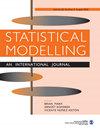多层次模型中有序水平2预测因子的多重归算和选择:学生评分与教师实践和态度之间关系的分析
IF 1.2
4区 数学
Q2 STATISTICS & PROBABILITY
引用次数: 2
摘要
本文的动机是分析大学生评分与教师实践和态度之间的关系,这些关系是通过一项创新调查收集的一组二元和有序项目来衡量的。该分析是通过两级随机截距模型进行的,其中学生评分嵌套在教师中。分析必须面对两个关于测量教师实践和态度的项目的问题,这两个项目是2级预测因素:(a)由于教师的不回应,这些项目受到遗漏的严重影响;(b)其测量量表的项目数量和类别数量都存在冗余。我们通过考虑在学生和教师层面利用信息的多重插补策略来解决数据缺失问题。对于冗余问题,我们依赖正则化技术来进行有序预测,同时考虑多级数据结构。所提出的解决方案以独创的方式解决了手头的问题,并且无论何时需要选择受缺失值影响的2级预测因子,都可以应用该解决方案。最终模型的结果表明,对教师激励学生能力的评分与教师的某些做法和态度有关。本文章由计算机程序翻译,如有差异,请以英文原文为准。
Multiple imputation and selection of ordinal level 2 predictors in multilevel models: An analysis of the relationship between student ratings and teacher practices and attitudes
The article is motivated by the analysis of the relationship between university student ratings and teacher practices and attitudes, which are measured via a set of binary and ordinal items collected by an innovative survey. The analysis is conducted through a two-level random intercept model, where student ratings are nested within teachers. The analysis must face two issues about the items measuring teacher practices and attitudes, which are level 2 predictors: (a) the items are severely affected by missingness due to teacher non-response and (b) there is redundancy in both the number of items and the number of categories of their measurement scale. We tackle the missing data issue by considering a multiple imputation strategy exploiting information at both student and teacher levels. For the redundancy issue, we rely on regularization techniques for ordinal predictors, also accounting for the multilevel data structure. The proposed solution addresses the problem at hand in an original way, and it can be applied whenever it is required to select level 2 predictors affected by missing values. The results obtained with the final model indicate that ratings on teacher ability to motivate students are related to certain teacher practices and attitudes.
求助全文
通过发布文献求助,成功后即可免费获取论文全文。
去求助
来源期刊

Statistical Modelling
数学-统计学与概率论
CiteScore
2.20
自引率
0.00%
发文量
16
审稿时长
>12 weeks
期刊介绍:
The primary aim of the journal is to publish original and high-quality articles that recognize statistical modelling as the general framework for the application of statistical ideas. Submissions must reflect important developments, extensions, and applications in statistical modelling. The journal also encourages submissions that describe scientifically interesting, complex or novel statistical modelling aspects from a wide diversity of disciplines, and submissions that embrace the diversity of applied statistical modelling.
 求助内容:
求助内容: 应助结果提醒方式:
应助结果提醒方式:


